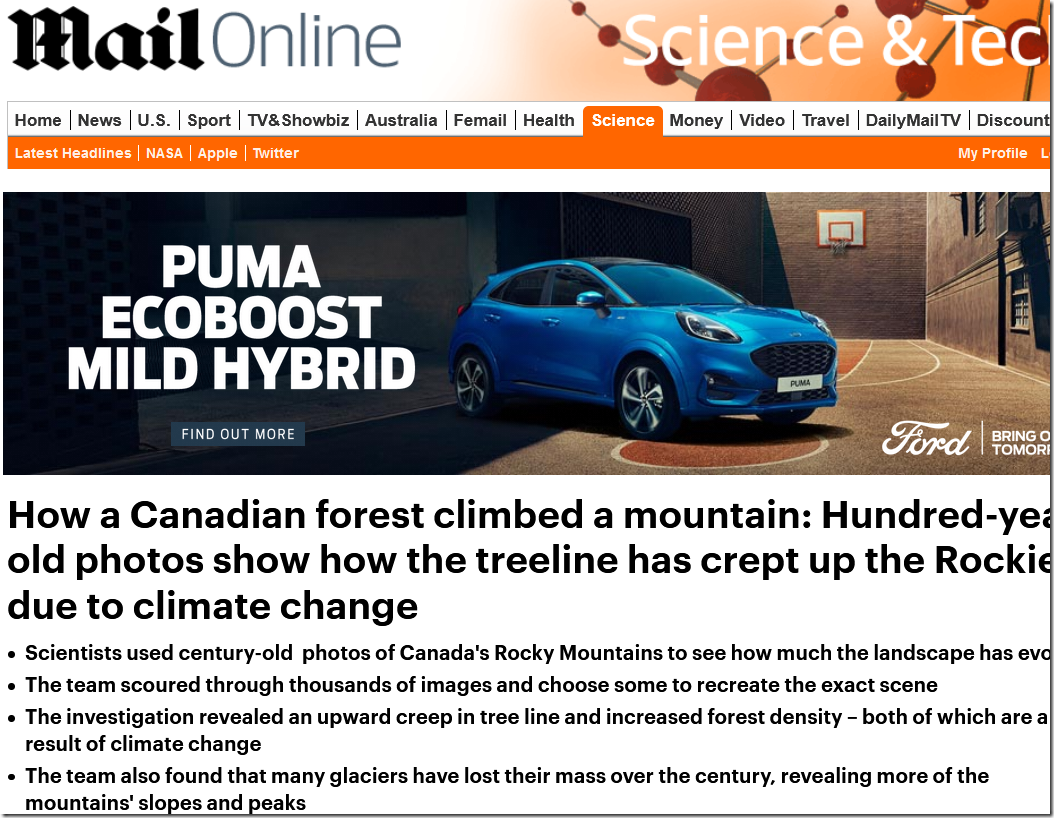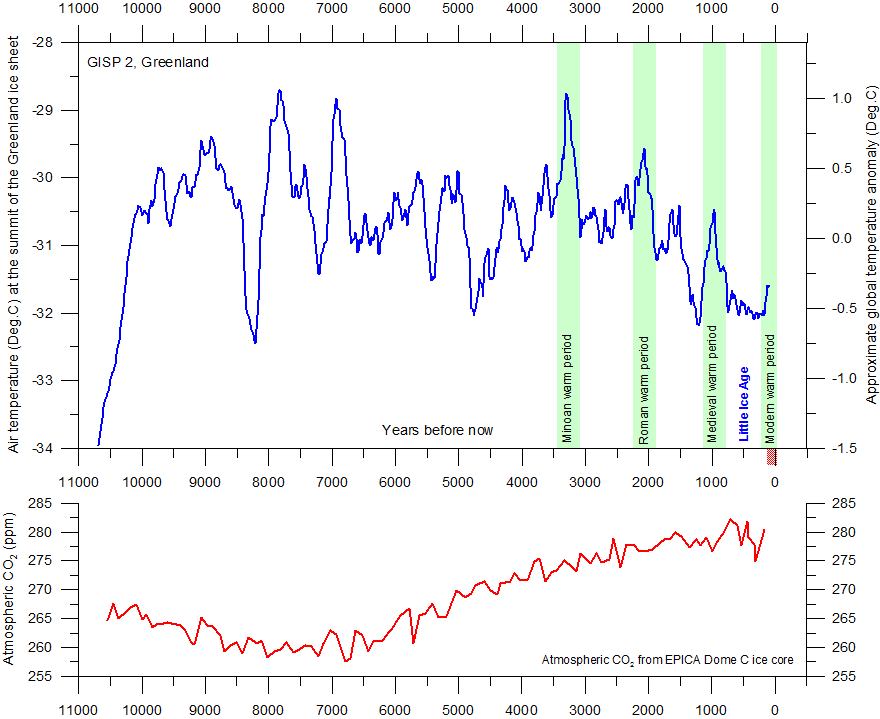Tree Lines Creeping Back Up In Rockies
By Paul Homewood
h/t Patsy Lacey
Brave pioneers trekked through unknown parts of the Canadian Rockies a century ago to take photographs of the region and build the area’s first topographical maps.
Fast forward to present day and scientists are using these timeless pictures to understand how much of the landscape has evolved over the past 100 years.
The team replicated different scenes to create exact comparisons of images taken by the early mountaineers, revealing an upward creep in tree line and increased forest density – both of which are a result of climate change.
Shots of mountains in Alberta show a dramatic change in snow on the peak and tree lines on the slope, while a hilltop in the Crowsnest Forest Reserve reveals an increase in vegetation than what was present 77 years ago.
Climate science has now become utterly corrupt.
Any competent scientist would know that tree lines in the Rockies have been dropping for centuries, with the last particularly precipitate decline during the Little Ice Age.
HH Lamb included this chart in his book, “Climate, History and the Modern World”:

https://notalotofpeopleknowthat.wordpress.com/2018/08/19/the-holocene-climate-optimum/
Fortunately the world has warmed up slightly since the 19thC, but tree lines are still much lower than in the past.
So are the authors of this latest study corrupt or simply incompetent?
Comments are closed.

perhaps both?
Same response as usual. Old wood/forests are revealed from under the melting ice, the tree-line was much higher in the relatively recent past.
https://www.livescience.com/4702-melting-glacier-reveals-ancient-tree-stumps.html
PS. You have to admire how the article turns it around into supporting unprecedented man-made warming!
Indeed there are many examples of evidence for warmer conditions during the Holocene to be found on the web despite the best efforts of google et al. to hide them, this is just one:

“… conifers have not yet recolonized many areas where trees were present during the Medieval Warm period (ca AD 800-1,300) or the Holocene Thermal Maximum (HTM; ca 10,000-3,000 years ago)”.
Climate change and the northern Russian treeline zone:
https://www.researchgate.net/publication/5841429_Climate_change_and_the_northern_Russian_treeline_zone
In fact it is the period when the ‘before’ photos were taken that was historically anomalous:
This study of the Siberian Taiga treeline comes to the same conclusion. Recent northward treeline advance brings it back to where it was in the MWP.
“So are the authors of this latest study corrupt or simply incompetent?”
I am voting for corrupt.
The before and now photos in the DM seem to me to show the absolute tree line hasnt changed much at all. Just the areas that have had trees and are now thicker and more spread out. That indicates that its self seeding as the existing trees allow more trees around them and so on.
The rest of the photos are of the decreased size of glacial areas, which was happening even at the turn of last century from the end of the Little Ice age
Foresters make the same distinction, I believe, between the absolute tree line and the forest line. The latter marking the upper extent of where the trees are dense enough to form a continuous canopy.
A related article from years ago:
Historical Aspects of the Northern Canadian Treeline HARVEY NICHOLS (late ’70s paper)
Click to access Arctic29-1-38.pdf
ABSTRACT From palynological studies it appears that northernmost dwarf spruces of the tundra and parts of the forest-tundra boundary may be relicts from times of prior warmth, and if felled might not regenerate. This disequilibrium may help explain the partial incongruence of modern climatic limits with the present forest edge. Seedlings established as a result of recent warming should therefore be found within the northernmost woodlands rather than in the southern tundra.
I suspect part of the corruption is the changing of temperature data to support the lies of these assertions is currently happening. Tony Heller is exposing this too. See his latest videohttps://youtu.be/CqsvYAW1idg
Nice thing about skiing in the Colorado Rockies, as I found in 1990, is the high treeline, about 12,000 ft. Twice as high as the alps therefore no Whiteouts.
Twas ever thus!
‘Wood Porn,’ to add to ‘Hurricane Porn’? Amusing.
In business-cycle analysis, indicators of the state of the cycle are classified into “leading,” “coincident, ” and “lagging.” Tree position and quantity would obviously be usually a lagging indicator of climate change, as the life cycle of trees is long. As such, it is of zero relevance; for everybody accepts that the climate has ameliorated, in some sense, in the Northern Hemisphere, since the 19th Century.
I suppose that it might be a coincident indicator of increased carbon-dioxide. I like trees!
There is a story of a travelling bishop in the Middle Ages who looked sad while walking downhill and happy while walking uphill. His attendants asked him, “Why?”, and he replied
“When going down I am thinking of the inevitable trudge up to follow; and when toiling up I am thinking of the bliss of strolling down the other side.”
Trying to frighten people by wailing about trees growing better in some remote mountainous region is not, I opine, going to influence public opinion much. The enemy has shot its bolt, if this is the best it can do.
Again another great take down of what purports to be climate science Paul. But one quibble: its my experience that the majority of neutrals reading and listening to this type of alarmism are oblivious to the last circa two and a half million years of glacial history. As such, when fact checking and demolishing junk such as this I remain convinced that it is vital to include basic information about how tree lines etc wax and wane most especially in the ever changing temperature changes from the onset of interglacials through to the Optimums and then finally when they are concluding. Even without the relentless naked climate propagandizing of the media this would be hard enough for neutrals coming across climate science sceptic blogs to understand. Keep up the great work. Best to all. Eoin
Just a thought: would increased levels of CO2 help trees to thrive at higher altitudes?
LIkely. Our CO2 levels are still low coming out of the last ice age. Several papers discuss the very low levels of CO2 during the end of the Pleistocene may be a major reason for the demise of the mega fauna at that time. Low CO2 led to depauperate plant growth. Some plants even failed to reproduce under those circumstances. Thus there was less for herbivores to eat which meant that there were fewer herbivores for the carnivores to munch.
Tree line location is subject to several limiting factors, including wind, temperature, moisture, sunlight. Yes, increased CO2 could mitigate them.
They don’t react to the undefined generality of ‘climate change.’
in other places the treeline responds to changes in precipitation, but why worry about that.
My totally unscientific observation of trees and vegetation on Mountains in Majorca is over my 68 years it varies quite a bit. Add in to my study things that eat the trees such as numbers of goats and plagues of moth caterpillars, and basically I think I could prove anything.
I think it would be rather more terrifying for the general populace if they were informed that the glaciers were advancing.
We are afraid of change, it seems, even when that change is remote and will have no effect on our lives.
The article says, “They collected 8000 images of the early Canadian Rocky Mountain landscape from the database and selected a few to do comparisons.”
The word “selected” is a bit of a red flag. We know from the saga of ‘Gergis et al’ what happens when climate scientists “select” their data.
I have not seen a single climate change claim that has stood up to scrutiny: bears, penguins, glaciers, arctic-ice, reefs etc. Add to this the fiddling of historical data and one must wonder why the “clever people” in charge / policy-makers like Mr. Cummings (allegedly anyway) are not taking action.
Maybe they are all shielded by the virtue-cloak of climate dogma and never see the real world?
The primary media are the real rogues in this area as they are not reporting facts any more: they report the spurious claims with fanfares then do not report the proofs of error, creating total misinformation for the masses.